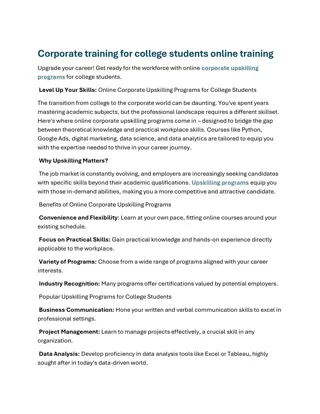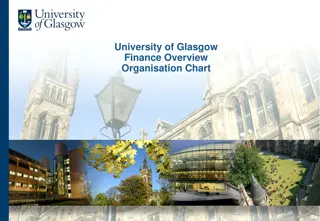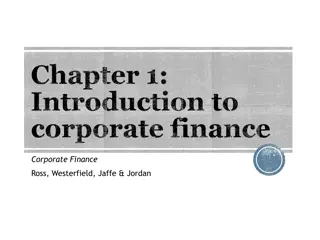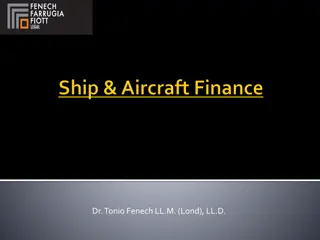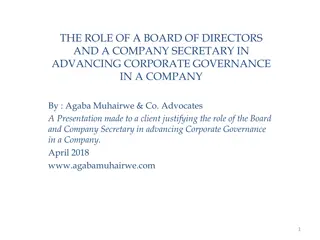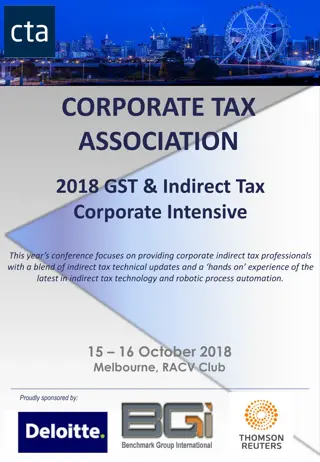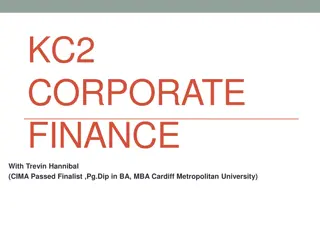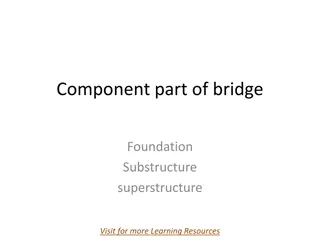New Foundations in Corporate Finance
This article explores the need for a new theory of the firm in the field of corporate finance, highlighting the shortcomings of existing theories and proposing characteristics of a more relevant theory. It delves into key arguments, contributions, and the historical origins of corporate finance, emphasizing the importance of understanding the theory of the firm for effective financial decision-making.
Download Presentation

Please find below an Image/Link to download the presentation.
The content on the website is provided AS IS for your information and personal use only. It may not be sold, licensed, or shared on other websites without obtaining consent from the author.If you encounter any issues during the download, it is possible that the publisher has removed the file from their server.
You are allowed to download the files provided on this website for personal or commercial use, subject to the condition that they are used lawfully. All files are the property of their respective owners.
The content on the website is provided AS IS for your information and personal use only. It may not be sold, licensed, or shared on other websites without obtaining consent from the author.
E N D
Presentation Transcript
In search of New Foundations _Luigi Zingales Prepared By Deepika Chhillar Spring 2021
Key Arguments and Contributions 1. Corporate Finance is deeply rooted in an underpinning theory of the firm 2. Existing theories of the firm have fallen short of explaining recent changes in the nature of the firm 3. Establishes the need for a new theory of the firm and outlines its characteristics
Five Sections of this Article I Analyzes what corporate finance is about and why it assumed this name II Explains why the name carried important consequences for the type of research that has been done and the type of problems that has been ignored. III Discusses how corporate finance is deeply rooted in an underpinning theory of the firm and illustrates the implications for corporate finance of the most important theories of the firm. IV Argues that although the existing theories have delivered very important and useful insights, they seem to be quite ineffective in helping us cope with the new type of firms that is emerging. V Outlines the characteristics that a new theory of the firm should satisfy and suggests how such a theory could change the way we do corporate finance, both theoretically and empirically.
Section I Corporate Finance (CF) Study of the way firms are financed OR the business of financing business. Distinct from real estate finance, personal/consumer finance etc. Three main areas of CF: Capital Structure Distortions associated with different ways of financing Corporate Governance Optimal governance structure for the firm Valuation Valuation of the firm
Section I & II - Origins of Corporate Finance Concerns the financing of enterprises, that is, unique combinations of physical and human capital For historical reasons, the idea of enterprise that became ingrained in corporate finance coincided with the legal notion of corporation Disproportionate focus on large firms Disproportionate amount of research dedicated to large publicly traded companies is simply an effect of data availability The access to datasets, such as COMPUSTAT, facilitated this type of research, whereas the difficulty in obtaining information about privately held companies prevented the other type
Section III Theory of the firm foundations of CF (I/II) Why do we need this link? Many unanswered questions: Capital Structure Perspective - Why value is lost in liquidating a firm Why a firm is worth more than the sum of all its components? Need to understand what a firm is, and how it adds value with regard to the market Governance Perspective - Why do we need any form of authority? Isn t the market responsible for allocating all resources efficiently without the intervention of any authority?
Section III Theory of the firm foundations of CF (II/II) Valuation Perspective Value created by a firm = Discounted sum of the payoffs generated by the the firm Opportunity cost of the inputs used This economic understanding of firm s valuation leaves out gaps in our understanding of the true value of firm E.g., Unionized workers tend to be paid above their opportunity cost. Total value of the firm, thus, should include the rent appropriated by unions.
Section IV Existing Theories of the Firm .. And their Incompleteness Firm as a Nexus of Explicit and Implicit Contracts Firm as a Collection of Growth Options Firm as a Collection of Assets
View A : Firm as a Nexus of Explicit and Implicit Contracts May seem like a minor variation of only explicit contracts (Alchian & Demestz, 1972; Jensen & Meckling, 1976) prevailing view of the firm in corporate finance, but it changes conceptual framework dramatically A firm sum of components readily available on the market BUT is a unique combination, which can be worth more or less than the sum of its parts Difference being the net of value of organizational assets & liabilities => Organizational Capital E.g., Suppliers and Customers have implicit contracts with the firm
View B : Firm as a Collection of Growth Options Myers (1977) defines the firm as a collection of assets in place and growth opportunities Two shortcomings ( incomplete): Does not provide explanations of what the glue is that keeps the growth opportunities attached to the assets in place How the inner workings of this entity differ from the workings of the marketplace
View C : Firm as a Collection of Assets Shortcoming : Why do firms spend billions to merge? If the firm is simply a collection of contracts, the results achieved through a merger could be more simply obtained by writing a contract between two separate firms.
Firms are changing! A typical firm is no longer a Chandlerian firm - i.e., asset intensive and highly vertically integrated (Richard Whittington warns against this though!) Traditional firm had a high degree of control over its employees. Now, employees are not merely automata in charge of operating valuable assets but valuable assets themselves, operating with commodity-like physical assets. Owing to size and asset intensity, traditional firms had disperse investors
The New Firm Three major changes in the balance of power within firms: Physical assets have become less unique Improvements in capital markets have made it easier to finance expensive assets Increased global competition has increased demand for process innovation, which can only be generated by talented employees Importance of HC. Firms have lost their grip on HC due to increased employees outside options
Features of the new firm Non-vertically integrated Human capital-intensive Operates in a highly competitive environment Exercise of authority by the HQ is severely limited by the ability of employees to quit, taking with them their HC or even a part of the firm (e.g., consulting)
Section V A New Agenda Questions must be addressed by the new theory of the firm: 1. The defining characteristic of a firm is that it substitutes authority for the price mechanism in determining how decisions are made (Coase (1937). Theory of the firm should address - how an organization succeeds in acquiring power that differs from "ordinary market contracting between any two people specially in the absence of physical asset-intensive firms 2. How is power maintained and how is it lost? 3. How does authority-based system operated in a way different from ordinary market contracting? Understanding the internal workings of firms 4. How the surplus generated by the firm is allocated among its members
A New Theory of the Firm - An attempt Q1 How a third party can have control over human capital.. ? By controlling a critical resource an entrepreneur can influence the accumulation of specific investments so as to build complementarities between the person the entrepreneur seeks to have power over and her critical resource. Once the complementarity exists, the specialized person may obey orders from the entrepreneur for fear that disobedience would jeopardize the joint value they can create together. Q2 - How is power maintained and how is it lost? Power is maintained and increased by having more and more people specializing; thus, at some point the critical resource becomes the web of specific investment itself
Open-ends (non-exhaustive list) 1. There is a pressing need to understand what factors determine the ability of firms to capture new growth opportunities. The theory focuses on the A- cap? degree of complementarity. But how can we measure it? And what is the predictive power of such an idea? An answer to these questions will be crucial to deriving the value of the entire enterprise. 2. We need to know how the surplus generated by a firm is allocated among its members.
Conclusion: Important to Build a New Theory of the Firm Emphasize that we need a new theory of the firm, specially to change the ways we study corporate finance, both theoretically and empirically.
Discussion Questions Traditional firms valuation would be able to capture the value of assets (mostly physical). What are some measures for measuring human capital their talent and other qualitative aspects? Similarly, access to data resources (E.g., Facebook, Google) How does a merging of two stakeholders, say, suppliers and customers, as in the case of platforms such as Facebook, Tinder, etc. change the balance of attention/power/claimant rights? Relatedly, should users of these data-collection applications receive more property rights (pie- share)?







